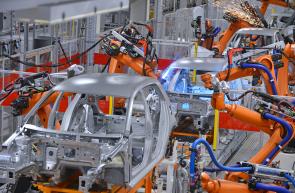TSN is set to become a must in the industry, according to Moxa
Time-Sensitive Networking (TSN) is acknowledged to represent the future of industrial Ethernet, as it sets the foundation for data-driven interconnected, smart factories. More than a simple, product-level solution, the technology offers a systemic solution to support determinism, convergence and process transparency. These ground-breaking features are the reason why TSN adoption has already occurred with leading automation vendors.
Chih-Hong Lin, Global Technology Partner Manager at Moxa, a leader in industrial communications and networking with a focus on securing industrial networks, and also a member of the CC-Link Partner Association (CLPA), looks at the role of TSN in shaping the future of industrial automation.
The Connected Industries of the future will rely on a single, converged network. This facilitates access to data by enabling both vertical and horizontal communications in order to share actionable insights across the entire enterprise. Ultimately, the knowledge gathered will drive productivity and competitiveness. By simplifying the architecture behind unified industrial communications, such a setup can also considerably simplify network architectures as well as maintenance activities, reducing costs.
Chih-Hong Lin explains: “This vision for future-oriented data sharing, in line with Industry 4.0, is in stark contrast to legacy communications, characterised by ‘islands of automation’ where machines are mostly isolated. This means that we currently have to rely on multiple, often semi-proprietary standards to share data within the different layers of the automation pyramid.
“Besides, each protocol can rarely communicate with the others, preventing the transfer of key information across the enterprise. Even more, as machines and systems expand, networks become increasingly complex to address these changes.”
Getting ready for next-gen networks
Therefore, existing network technologies – even when well established – may not be able to address the needs of next-gen industries. A first, significant step to address change is the use of solutions offering large bandwidth, i.e. 1 Gbit/s. Chih-Hong explains: “One of the reasons why systems have remained partially isolated is to avoid interference. As businesses move away from this model and enlarge their networks, they need sufficient bandwidth to guarantee that time-critical data, such as control traffic, can always be transferred in a deterministic manner. By doing so, they can support more applications and start benefitting from the gains offered by converged networks.”
The next step is to implement TSN technology, whose relevance has rapidly grown. “When I first came across TSN, about five to six years ago, I thought it was just another technology with limited impact. But the more I learned about it, and as the standards behind TSN developed, the more I could see the game-changing role of this solution for next-level communications. It is now clear how TSN will change industrial automation and the way we currently run businesses,” Chih-Hong Lin comments.
Businesses around the world are well-aware that TSN is the enabler for Industry 4.0 as it can unleash their full potential by supporting converged, deterministic networks that are at the core of smart, interconnected factories. “We see a growing number of very proactive players in the industry that are keen on adopting TSN. In particular, the Asian market is moving particularly fast, embracing the technology and developing innovative real-world applications and use cases. Nonetheless, more conservative companies, which may be more hesitant in investing in TSN now, still recognise the role of this solution in futureproof industrial automation,” adds Chih-Hong Lin.
Succeeding in TSN implementations
Being such a revolutionary technology, TSN requires a comprehensive ecosystem for its successful implementation. Chih-Hong Lin explains: “Adopting this technology means applying it on a systemic level, rather than as a single product. Therefore, two main requirements need to be addressed. Firstly, it is necessary to have strong support from an industrial Ethernet organisation such as the CLPA, to deliver suitable TSN-compatible network technologies. Secondly, it is essential to have a broad range of available products supporting this technology. CC-Link IE TSN can meet these two requirements.” It is the first gigabit Ethernet with TSN capabilities and the most advanced solution currently available. Also, it offers the most complete system, with many compatible automation products on the market.
An additional aspect to succeed in embracing TSN is achieving interoperability. This is a must to address the need of the smart factories of the future. To overcome this issue, Moxa is actively taking part in a number of activities. “In addition to launching CC-Link IE TSN compatible products, we are involved in TSN testbeds as well as discussing with other leading automation vendors how to shape our solutions to support customers in the most effective way,” says Chih-Hong Lin.
He adds: “The key to success is collaborating. By working together as a team, automation vendors, machine builders and users can help shape TSN so that it addresses our needs.” This is why partnerships within leading organisations, such as the CLPA, are highly beneficial, as they provide a unique forum to guide businesses towards the future of industrial automation.
The future is already here
Chih-Hong Lin continues: “There are more and more real-world applications of TSN, and I expect to see larger scale implementations of this technology by next year, while mass adoption of TSN in entire factories should happen in the near future”. While many products and solutions are still being developed, Chih-Hong Lin concludes by suggesting companies should embrace change now. “A proactive approach is the most efficient, as it supports a stage-like implementation. Waiting until TSN is a mature technology will likely be too costly and time-consuming, while leaving businesses behind. Ultimately, I think TSN will become an industry standard. As adoption grows, more uses will be discovered, ultimately making this technology an essential element of industrial operations.”
About The CC-Link Partner Association (CLPA)
The CLPA is an international organisation founded in 2000, now celebrating its 20th Anniversary. Over the last 20 years, the CLPA has been dedicated to the technical development and promotion of the CC-Link family of open automation networks. The CLPA's key technology is CC-Link IE TSN, the world's first open industrial Ethernet to combine gigabit bandwidth with Time Sensitive Networking (TSN), making it the leading solution for Industry 4.0 applications. Currently the CLPA has almost 3,800 member companies worldwide, and more than 2,000 compatible products available from over 340 manufacturers. Around 30 million devices using CLPA technology are in use worldwide.
Further Information:
Website: eu.cc-link.org
LinkedIn: https://www.linkedin.com/company/cc-link-partner-association-europe/
Twitter: twitter.com/cc_linknews
YouTube: youtube.com/user/CLPAEurope
Editorial contact:
DMA Europa Ltd. : Anne-Marie Howe
Tel: +44 (0)1562 751436 Fax: +44 (0)1562 748315
Web: www.dmaeuropa.com Email: anne-marie@dmaeuropa.com
Address: Europa Building, Arthur Drive, Hoo Farm Industrial Estate, Kidderminster, Worcestershire, DY11 7RA, UK
Reader contact:
CLPA-Europe : John Browett
Tel: +44 (0) 7768 338708 Fax: +49 (0) 2102 532 9740
Web: eu.cc-link.org Email: john.browett@eu.cc-link.org
Address: Postfach 10 12 17 40832 Ratingen Germany

Businesses around the world are well-aware that TSN is the enabler for Industry 4.0 as it can unleash their full potential by supporting converged, deterministic networks that are at the core of smart, interconnected factories. (© Moxa)

More than a simple, product-level solution, the Time-Sensitive Networking offers a systemic solution to support determinism, convergence and process transparency. (© Moxa)

Chih-Hong Lin, Global Technology Partner Manager at Moxa. (© Moxa)
- Ассоциация Партнеров CC-Link (CLPA)
Сайт членов партнерской ассоциации 



